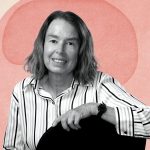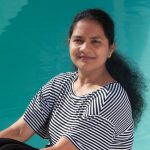Next Gen Rajasree Kalagiri Bound to phosphohistidine
Growing up in the small town of Karimnagar in southern India, Rajasree Kalagiri attended a school funded by the Indian government to uplift talented students from rural communities. “I wanted to give back to the society,” she says.
But toward the end of high school, a biology teacher’s detailed answers to her many questions during class stoked Kalagiri’s interest in science. She went to Vivekananda Degree College, where she studied chemistry and microbiology. Her college couldn’t afford textbooks, so lessons were taught from Xeroxed handouts assembled from various sources. Kalagiri says it wasn’t until her master’s education at Osmania University that she got her first real textbook, Lehninger’s Principles of Biochemistry, which completed her understanding of many concepts. “That really opened me up to the scientific world,” she says.
After her master’s degree, Kalagiri assumed she would look for a job in industry. “In my small town, we didn’t have much information about how science is done in the laboratory or how to pursue science as a career,” she says. “Even during my master’s, I never thought that I could be a scientist or that I could get into a PhD program.”
Luckily, Kalagiri’s mentors convinced her to apply, and she received offers from five different PhD programs, ultimately picking the prestigious Indian Institute of Science for its molecular biophysics division. There, she joined an X-ray crystallography lab headed by Professor Balasubramanian Gopal—a decision she says was inspired by English chemist Rosalind Franklin, who in the early 1950s was one of the first scientists to use X-ray crystallography to determine the structure of DNA.
In X-ray crystallography, scientists shoot a beam of X-rays at a crystalline sample and analyze how the X-rays are spread to reconstruct the sample’s atomic structure. Over the past several decades, researchers have made great advances in image reconstruction and have revealed the structure of important biological molecules such as insulin and antibiotic compounds using this approach.
As a graduate student, Kalagiri used the technique to study how the common yet deadly bacteria Staphylococcus aureus communicates. Specifically, she focused on a molecule known as phosphohistidine that serves as a switch in signaling pathways in bacteria. The molecule is also present in humans, and although its role is largely unknown, its dysregulation has been connected to a number of diseases such as liver and breast cancer and neuroblastoma.
Phosphohistidine is an incredibly sensitive molecule present in proteins, which makes it great for rapid signaling in cells but very difficult for scientists to study. She would sometimes travel to a collaborator’s lab and set up a full day of phosphohistidine experiments, only to watch them fail when the molecule fell apart. Though this molecule was frustrating to study, she persisted and completed her project successfully.
After her PhD, she joined her husband, Praveen, in San Diego and took a break from research to have her first child, Prahersh. Her second son, Dhruvin, was born this past summer.
Soon after arriving in Southern California, Kalagiri heard that a nearby lab, run by Professor Tony Hunter at the Salk Institute, had developed antibodies that bind to phosphohistidine. At the time, only a few labs around the world had been able to do so successfully. These antibodies could be used to study phosphohistidine in great detail, providing insights into the molecule that Kalagiri wishes she would have had during graduate school.
In 2016, Kalagiri reached out to Hunter about becoming a postdoctoral researcher in the lab. She was unsure if she’d be good candidate, as she didn’t have experience in the lab’s focus area, cancer biology, but she couldn’t resist asking anyway. Her request paid off: Hunter invited Kalagiri to give a talk on her research to the group, and afterwards offered her a position.
Using her X-ray crystallography expertise, Kalagiri examined the antibodies’ structures to figure out what made them so good at binding to phosphohistidine. She recently published her findings jointly with collaborators in a PNAS paper that revealed never-before-seen details about the antibodies’ binding sites (see this issue’s “Discoveries”). These insights could help scientists understand phosphohistidines’ potential role in certain forms of cancer and also design better antibodies.
It’s been a thrill to do research at the same institute as many of her scientific heroes, Kalagiri says. When she first arrived, she recalled having attended a talk years earlier at her university by past Salk President Elizabeth Blackburn, after Blackburn won the Nobel Prize in Physiology. “I saw her, and thought, ‘Is this real? Am I going to work in the same place as her?’”
Although she finds it surprising, Kalagiri paved a path to Salk through her scientific excellence and perseverance in pursuing an incredibly challenging protein modification. “During my PhD, I sometimes despised working with this elusive molecule. I would think, ‘Maybe I should move away from phosphohistidine,’ but somehow I was obsessed with it,” she says with a laugh. Like the lab’s antibodies, Kalagiri is firmly bound to phosphohistidine for the foreseeable future.
Featured Stories
 The aging puzzle comes togetherAging is a complex puzzle, but by applying a collaborative, multidisciplinary approach, Salk scientists are putting its many pieces together.
The aging puzzle comes togetherAging is a complex puzzle, but by applying a collaborative, multidisciplinary approach, Salk scientists are putting its many pieces together. Dmitry Lyumkis – A passion for problem solvingAssistant Professor Dmitry Lyumkis discusses what he loves about data and the scientific process, and which places inspire him outside the lab.
Dmitry Lyumkis – A passion for problem solvingAssistant Professor Dmitry Lyumkis discusses what he loves about data and the scientific process, and which places inspire him outside the lab.
 Pamela Maher – Seeking treatments for Alzheimer’s diseaseFrom having a large garden to investigating compounds that plants make, Staff Scientist Pam Maher talks about how plants inspire her to find treatments for Alzheimer’s disease.
Pamela Maher – Seeking treatments for Alzheimer’s diseaseFrom having a large garden to investigating compounds that plants make, Staff Scientist Pam Maher talks about how plants inspire her to find treatments for Alzheimer’s disease. Rajasree Kalagiri – Bound to phosphohistidineRajasree Kalagiri shares the serendipitous steps along her journey of scientific discovery from southern India to Southern California.
Rajasree Kalagiri – Bound to phosphohistidineRajasree Kalagiri shares the serendipitous steps along her journey of scientific discovery from southern India to Southern California.





















































